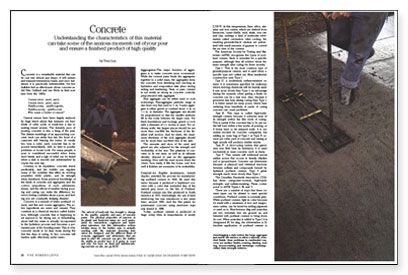Understanding Concrete
Understanding the characteristics of this material can take some of the anxious moments out of your pour and ensure a finished product of high quality.

Synopsis: Good background reading on the properties of concrete. It discusses types of portland cement, strength, curing times, mixing proportions, and the use of admixtures. A sidebar has tips for ordering ready-mix concrete.
Concrete is a remarkable material that can be cast into almost any shape. It will sustain and transmit tremendous loads, and once hardened, it is practically indestructible.
Cement mixers have been largely replaced by huge batch plants that measure out hundreds of cubic yards of ready-mix a day to waiting transit mixers. The leisurely pace of pouring concrete is also a thing of the past. The distant rumblings of an approaching concrete truck can strike fear into the heart of a carpenter still bracing the forms. At nearly two tons a cubic yard, concrete has to be poured immediately, with no time to ponder problems or locate tools. For many people, a pour is considered successful when forms don’t break; and a sigh of relief can be heard when a slab is smooth and unblemished by cracks the next day.
Contrary to its reputation, concrete reacts predictably, and the builder can regulate many of the variables that affect its working properties while plastic, and its strength when hardened. Some practical knowledge of the kinds of cements and aggregates and the correct proportions of each, admixtures, slump, and the effects of weather during pouring and curing can make the difference between feeling confident about a pour, and feeling you are constantly dodging disaster.
Concrete is a mixture of water, portland cement, and fine and coarse aggregates. The active ingredients are water and cement. They combine in a chemical reaction called hydration. Although concrete that is beginning to set appears to be drying out, or dehydrating, about half the water is actually incorporated in the hydration process and becomes a permanent part of the bonding paste. This is why concrete needs to be kept moist during the first few days of curing. In fact, concrete will harden quite effectively under water.
Aggregates
The major function of aggregates is to make concrete more economical. While the cement paste binds the aggregates together in a solid mass, the aggregates keep the concrete from shrinking and cracking as hydration and evaporation take place during setting and hardening. Neat, or pure, cement is not nearly as strong as concrete correctly proportioned with aggregate.
For more photos and details, click the View PDF button below:


























